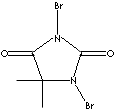| CAS
NO. |
77-48-5 |

|
| EINECS NO. |
201-030-9 |
| FORMULA |
C5H6Br2N2O2 |
| MOL
WT. |
285.92
|
|
H.S.
CODE
|
2933.21 |
|
TOXICITY
|
Oral rat LD50: 250 mg/kg |
| SYNONYMS |
1,3-Dibromo-5,5-dimethylhydantoin; |
| 1,3-Dibromo-5,5-dimethyl-2,4-imidazolidinedione;
DBDMH; Dibromantine; N,N'-Dibromodimethylhydantoin; |
| SMILES |
|
|
CLASSIFICATION
|
DISINFECTANTS
/ |
|
PHYSICAL AND CHEMICAL PROPERTIES
|
| PHYSICAL
STATE |
white
to off-white powder
|
| MELTING POINT |
197 - 203 C |
| BOILING
POINT |
368-376 C |
| SPECIFIC GRAVITY |
|
| SOLUBILITY
IN WATER |
slightly
soluble |
| pH |
|
| VAPOR DENSITY |
|
|
AUTOIGNITION
|
|
|
NFPA
RATINGS
|
Health: 2 Flammability: 0 Reactivity: 1 |
|
REFRACTIVE
INDEX
|
|
| FLASH
POINT |
|
| STABILITY |
Stable
under ordinary conditions. Moisture sensitive |
|
APPLICATIONS
|
|
Dibromantin
is used as a brominating agent for organic
synthesis especially for pharmaceuticals
and hormones. It can be replaced for n-Bromosuccinimide.
(n-Bromo derivatives and ammonium tribromides are main brominating agents) |
| SALES
SPECIFICATION |
|
APPEARANCE
|
white
to off-white powder |
|
CONTENT |
98.0%
min
|
|
BROMINE CONTENT |
54.0%
min
|
| TRANSPORTATION |
| PACKING |
25kgs
in drum
|
| HAZARD CLASS |
not
regulated |
| UN
NO. |
|
| OTHER
INFORMATION |
|
Hazard
Symbols: XN, Risk Phrases: 22-34-43-50, Safety Phrases:
26-36/37/39-45-61 |
|
GENERAL
DESCRIPTION OF HYDANTOIN
|
|
Hydantoin derived from imidazole is one of a class of organic heterocyclic
compounds of five-membered ring structure composed of three carbon atoms and two
nitrogen atoms at nonadjacent positions with dione form. It is a white
crystalline compound; slightly soluble in water; melting at 222 C. Hydantoin
and its derivatives are is used in textile softeners and
lubricants. They are used in manufacturing pharmaceuticals (especially central
nervous system drugs), biocides, resins, preservatives and agrochemicals. |
